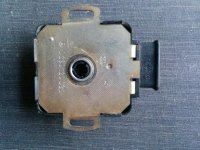Brad Anders Rennlist site (D-jet especially for Porsche 914) contains the following. Supports your bucking problem as TPS related
I'd say replace if can...
-----------------------
http://members.rennlist.com/pbanders/djetparts.htm#troubleshoot
Throttle Switch
Function: Senses throttle opening (not closing), sending pulse signals to the ECU to richen the mixture for acceleration. Also senses when the throttle is closed at idling, sending a signal to the ECU to provide idle mixture compensation. Also sends a signal at wide-open-throttle, but this signal is not used by the ECU for full-load enrichment, which is handled by the Manifold Pressure Sensor.
Failure Modes:
Track Wear: Over time, the wiper track for the accelerator function will wear. Wear will be especially high at moderate to light throttle angles, corresponding to part-load cruising. Click here for a link to a 60X photo of accelerator track wear. While this TPS track is still good, the re-deposition of gold worn from the contact fingers by the wiper can be seen, and eventually will become sufficient to bridge the traces. This wear causes arcing and poor contact, resulting in the car "bucking" at a constant throttle angle. "Bucking" is a fairly common complaint and is almost always due to track wear. Check by disconnecting the harness plug to the throttle switch and driving at a constant throttle angle under part-load. If the bucking is gone, it's due to the switch. As I mentioned earlier, if you go to
http://www.914world.com/ and search for user "davesprinkle", he's made a kit to replace the worn circuit board that restores your TPS to like-new condition.
Maladjustment: The throttle switch needs to be precisely aligned to ensure that the idle switch is properly actuated, and that the full extent of acceleration is covered over the range of operation. Poor idle performance and transition to full-load are affected if the switch is maladjusted. The Pelican Parts web site has a very good article on how adjust the switch, using an ohmmeter.
Notes: The car will still run even if the throttle switch is removed! It will accelerate slowly, and the idle may be poor, but it will run. Proper adjustment of the throttle switch is critical. If the idle switch does not actuate when the throttle is closed, the idle circuit in the ECU will not be activated and poor idle performance will result. Additionally, cars with ECU's that provide over-run fuel shutoff will not shut off the fuel if the idle switch isn't actuated when the throttle is closed while coasting. Proper adjustment of the throttle is also important. If the throttle cable and pedal stop are not properly adjusted so that the throttle is completely open when the throttle is fully depressed, fewer acceleration pulses will be provided to the ECU for acceleration enrichment, and you'll be restricting your full-throttle input, reducing horsepower.
I recently found out about two products that can be used on the contact tracks to extend their life. Deoxit D-5 cleans and leaves a lubricating film. It's available from CAIG Laboratories (
http://www.caig.com ). Another similar product is Stabilant 22 (VW part # ZVW 186001, Car Quest # SL-5). To use, you must open the throttle switch - be careful, there are some rubber positioning blocks that may fall out. Spray the contact track area and use a Q-tip to remove any excess.



